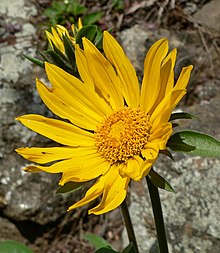
Gaillardia is a genus of flowering plants in the family Asteraceae, native to North and South America. It was named after Maître Gaillard de Charentonneau, an 18th-century French magistrate who was an enthusiastic botanist. The common name may refer to the resemblance of the inflorescence to the brightly patterned blankets made by Native Americans, or to the ability of wild taxa to blanket the ground with colonies. Many cultivars have been bred for ornamental use.

Helianthus is a genus comprising about 70 species of annual and perennial flowering plants in the daisy family Asteraceae commonly known as sunflowers. Except for three South American species, the species of Helianthus are native to North America and Central America. The best-known species is the common sunflower. This and other species, notably Jerusalem artichoke, are cultivated in temperate regions and some tropical regions, as food crops for humans, cattle, and poultry, and as ornamental plants. The species H. annuus typically grows during the summer and into early fall, with the peak growth season being mid-summer.

Palafoxia, or palafox, is a genus of North American flowering plants in the Bahia tribe within the Asteraceae.

Grindelia (gumweed) is a genus of plants native to the Americas belonging to the family Asteraceae. The genus was named for Latvian botanist David Hieronymus Grindel, 1776–1836.

Hymenoxys is a genus of plants in the sunflower family, native to North and South America. It was named by Alexandre Henri Gabriel de Cassini in 1828.
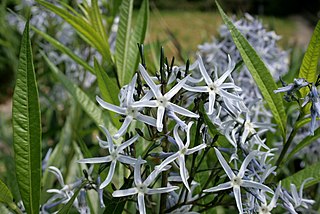
Amsonia is a genus of flowering plants in the dogbane family, Apocynaceae, first described as a genus in 1788. It is native primarily to North America with one species in East Asia and another in the eastern Mediterranean. It was named in honor of the American physician John Amson. Members of the genus are commonly known as bluestars.
- Amsonia ciliataWalter – fringed bluestar – SE US, S Great Plains
- Amsonia elliptica(Thunb. ex Murray) Roem. & Schult. – Japanese bluestar – China, Japan, Korea
- Amsonia fugateiS.P.McLaughlin – San Antonio bluestar – New Mexico
- Amsonia grandifloraAlexander – Arizona bluestar – Arizona, Sonora, Durango
- Amsonia hubrichtiiWoodson – Hubricht's bluestar – Arkansas, Oklahoma
- Amsonia illustrisWoodson – Ozark bluestar – Mississippi Valley, also Nevada
- Amsonia jonesiiWoodson – Jones' bluestar – Arizona, New Mexico, Utah, Colorado
- Amsonia kearneyanaWoodson – Kearney's bluestar – Baboquivari in Pima Co. in Arizona
- Amsonia longifloraTorr. – tubular bluestar – Arizona, New Mexico, Texas, Coahuila
- Amsonia ludovicianaVail – Louisiana bluestar – Louisiana, Mississippi, Georgia
- Amsonia orientalisDecne. – European bluestar – Greece, Turkey
- Amsonia palmeriA.Gray – Palmer's bluestar – Arizona, New Mexico, Texas, Sonora, Chihuahua
- Amsonia peeblesiiWoodson – Peebles' bluestar – Arizona
- Amsonia repensShinners – creeping bluestar – E Texas, SW Louisiana
- Amsonia rigidaShuttlw. ex Small – stiff bluestar – from Georgia to Louisiana
- Amsonia tabernaemontanaWalter – eastern bluestar – S + C + E United States
- Amsonia tharpiiWoodson – feltleaf bluestar – W Texas, SE New Mexico
- Amsonia tomentosaTorr. & Frém. – woolly bluestar – SW US; Chihuahua

Stephanomeria is a genus of North American plants also known as wirelettuce, belonging to the tribe Cichorieae within the family Asteraceae.

Heterotheca, are North American plants in the family Asteraceae.

Isocoma, commonly called jimmyweed or goldenweed, is a genus of North American semi-woody shrubs in the family Asteraceae. It is found in the semi-arid areas of Southwestern United States and Mexico.
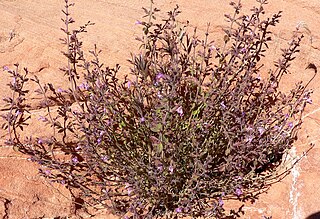
Hedeoma is a genus of flowering plants in the mint family, Lamiaceae. It is native to North and South America. They are commonly known as false pennyroyals.
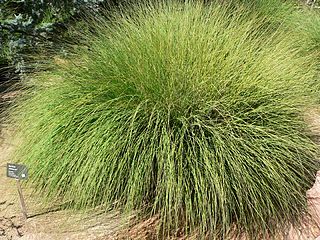
Muhlenbergia is a genus of plants in the grass family.
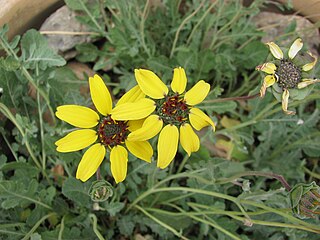
Berlandiera is a genus of flowering plants in the family Asteraceae.
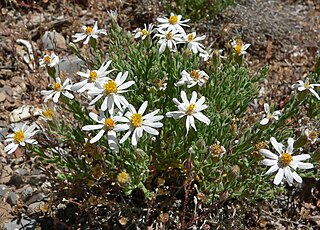
Chaetopappa is a genus of plants in the family Asteraceae which are known generally as leastdaisies.

Senecio flaccidus, formerly recorded as Senecio douglasii, member of the daisy family and genus Senecio also known as threadleaf ragwort, is a native of the southwestern Great Plains of North America.

Hymenopappus is a genus of flowering plants in the daisy family. Many species are known as woollywhites.

Aphanostephus (dozedaisy) is a genus of flowering plants in the family Asteraceae.
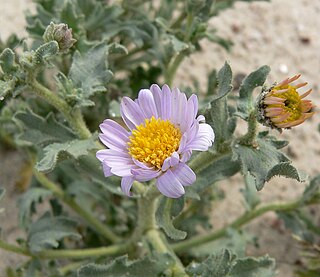
Arida is a genus of flowering plants in the daisy family, Asteraceae.
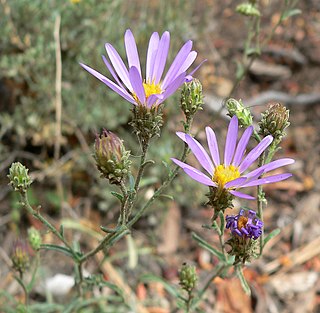
Dieteria is a North American genus of flowering plants in the family Asteraceae.
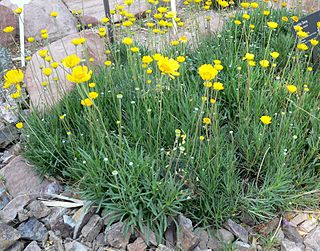
Tetraneuris, commonly known as four-nerve daisy or bitterweed, is a genus of North American plants in the sneezeweed tribe within the daisy family.

Poliomintha is a genus of flowering plants in the mint family, Lamiaceae. It is native to the southwestern United States, Haiti, and northern Mexico.
